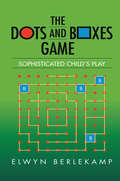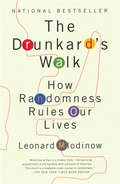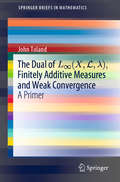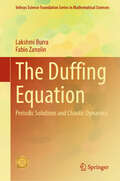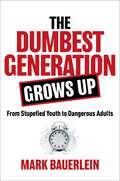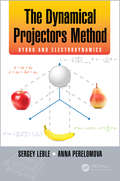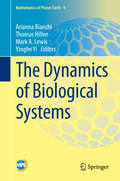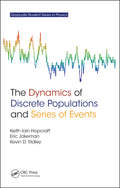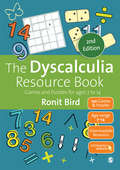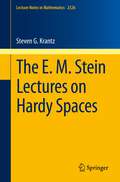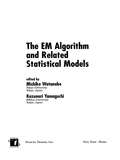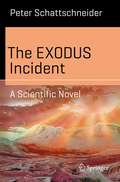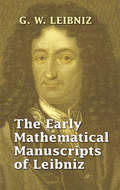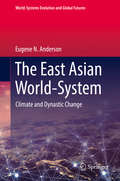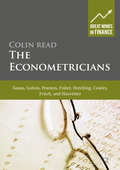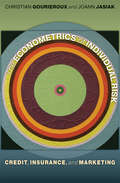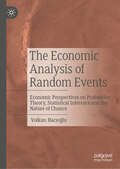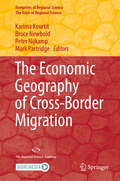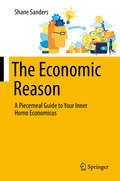- Table View
- List View
The Dots and Boxes Game: Sophisticated Child's Play (AK Peters/CRC Recreational Mathematics Series)
by Elwyn R. BerlekampThe game of Dots-and-Boxes, the popular game in which two players take turns connecting an array of dots to form squares, or boxes has long been considered merely a child's game. In this book, however, the author reveals the surprising complexity of the game, along with advanced strategies that will allow the reader to win at any level of gamepla
The Drunkard's Walk: How Randomness Rules Our Lives
by Leonard MlodinowWith the born storyteller's command of narrative and imaginative approach, Leonard Mlodinow vividly demonstrates how our lives are profoundly informed by chance and randomness and how everything from wine ratings and corporate success to school grades and political polls are less reliable than we believe.By showing us the true nature of chance and revealing the psychological illusions that cause us to misjudge the world around us, Mlodinow gives us the tools we need to make more informed decisions. From the classroom to the courtroom and from financial markets to supermarkets, Mlodinow's intriguing and illuminating look at how randomness, chance, and probability affect our daily lives will intrigue, awe, and inspire. From the Trade Paperback edition.d in another it was called the worst wine of the decade? Mlodinow vividly demonstrates how wine ratings, school grades, political polls, and many other things in daily life are less reliable than we believe. By showing us the true nature of change and revealing the psychological illusions that cause us to misjudge the world around us, Mlodinow gives fresh insight into what is really meaningful and how we can make decisions based on a deeper truth. From the classroom to the courtroom, from financial markets to supermarkets, from the doctor's office to the Oval Office, Mlodinow's insights will intrigue, awe, and inspire.Offering readers not only a tour of randomness, chance, and probability but also a new way of looking at the world, this original, unexpected journey reminds us that much in our lives is about as predictable as the steps of a stumbling man fresh from a night at the bar.From the Hardcover edition.
The Dual of L∞: A Primer (SpringerBriefs in Mathematics)
by John TolandIn measure theory, a familiar representation theorem due to F. Riesz identifies the dual space Lp(X,L,λ)* with Lq(X,L,λ), where 1/p+1/q=1, as long as 1 ≤ pL∞(X,L,λ)* cannot be similarly described, and is instead represented as a class of finitely additive measures.This book provides a reasonably elementary account of the representation theory of L∞(X,L,λ)*, examining pathologies and paradoxes, and uncovering some surprising consequences. For instance, a necessary and sufficient condition for a bounded sequence in L∞(X,L,λ) to be weakly convergent, applicable in the one-point compactification of X, is given.With a clear summary of prerequisites, and illustrated by examples including L∞(Rn) and the sequence space l∞, this book makes possibly unfamiliar material, some of which may be new, accessible to students and researchers in the mathematical sciences.
The Duffing Equation: Periodic Solutions and Chaotic Dynamics (Infosys Science Foundation Series)
by Lakshmi Burra Fabio ZanolinThis book discusses the generalized Duffing equation and its periodic perturbations, with special emphasis on the existence and multiplicity of periodic solutions, subharmonic solutions and different approaches to prove rigorously the presence of chaotic dynamics. Topics in the book are presented at an expository level without entering too much into technical detail. It targets to researchers in the field of chaotic dynamics as well as graduate students with a basic knowledge of topology, analysis, ordinary differential equations and dynamical systems. The book starts with a study of the autonomous equation which represents a simple model of dynamics of a mechanical system with one degree of freedom. This special case has been discussed in the book by using an associated energy function. In the case of a centre, a precise formula is given for the period of the orbit by studying the associated period map. The book also deals with the problem of existence of periodic solutions for the periodically perturbed equation. An important operator, the Poincaré map, is introduced and studied with respect to the existence and multiplicity of its fixed points and periodic points. As a map of the plane into itself, complicated structure and patterns can arise giving numeric evidence of the presence of the so-called chaotic dynamics. Therefore, some novel topological tools are introduced to detect and rigorously prove the existence of periodic solutions as well as analytically prove the existence of chaotic dynamics according to some classical definitions introduced in the last decades. Finally, the rest of the book is devoted to some recent applications in different mathematical models. It carefully describes the technique of “stretching along the paths”, which is a very efficient tool to prove rigorously the presence of chaotic dynamics.
The Dumbest Generation Grows Up: From Stupefied Youth to Dangerous Adults
by Mark BauerleinFrom Stupefied Youth to Dangerous Adults Back in 2008, Mark Bauerlein was a voice crying in the wilderness. As experts greeted the new generation of &“Digital Natives&” with extravagant hopes for their high-tech future, he pegged them as the &“Dumbest Generation.&” Today, their future doesn&’t look so bright, and their present is pretty grim. The twenty-somethings who spent their childhoods staring into a screen are lonely and purposeless, unfulfilled at work and at home. Many of them are even suicidal. The Dumbest Generation Grows Up is an urgently needed update on the Millennials, explaining their not-so-quiet desperation and, more important, the threat that their ignorance poses to the rest of us. Lacking skills, knowledge, religion, and a cultural frame of reference, Millennials are anxiously looking for something to fill the void. Their mentors have failed them. Unfortunately, they have turned to politics to plug the hole in their souls. Knowing nothing about history, they are convinced that it is merely a catalogue of oppression, inequality, and hatred. Why, they wonder, has the human race not ended all this injustice before now? And from the depths of their ignorance rises the answer: Because they are the first ones to care! All that is needed is to tear down our inherited civilization and replace it with their utopian aspirations. For a generation unacquainted with the constraints of human nature, anything seems possible. Having diagnosed the malady before most people realized the patient was sick, Mark Bauerlein surveys the psychological and social wreckage and warns that we cannot afford to do this to another generation.
The Dynamical Projectors Method: Hydro and Electrodynamics
by Sergey Leble Anna PerelomovaThe dynamical projectors method proves to reduce a multicomponent problem to the simplest one-component problem with its solution determined by specific initial or boundary conditions. Its universality and application in many different physical problems make it particularly useful in hydrodynamics, electrodynamics, plasma physics, and boundary layer problems. A great variety of underlying mechanisms are included making this book useful for those working in wave theory, hydrodynamics, electromagnetism, and applications. "The authors developed a universal and elegant tool – dynamical projector method. Using this method for very complicated hydro-thermodynamic and electrodynamics problem settings, they were able to get a lot of interesting analytical results in areas where before often just numerical methods were applicable." —L. A. Bordag, University of Applied Sciences Zittau/Görlitz, Zittau, Germany "The book is intended for professionals working in various fields of linear and nonlinear mathematical physics, partial differential equations and theoretical physics. The book is written clearly, and in my opinion, its material will be useful and easy to understand for professionals and for students familiar with ordinary and partial differential equations." —Sergey Dobrokhotov, Russian Academy of Sciences, Moscow, Russia
The Dynamics of Biological Systems (Mathematics of Planet Earth #4)
by Mark A. Lewis Thomas Hillen Yingfei Yi Arianna BianchiThe book presents nine mini-courses from a summer school, Dynamics of Biological Systems, held at the University of Alberta in 2016, as part of the prestigious seminar series: Séminaire de Mathématiques Supérieures (SMS). It includes new and significant contributions in the field of Dynamical Systems and their applications in Biology, Ecology, and Medicine. The chapters of this book cover a wide range of mathematical methods and biological applications. They - explain the process of mathematical modelling of biological systems with many examples, - introduce advanced methods from dynamical systems theory, - present many examples of the use of mathematical modelling to gain biological insight- discuss innovative methods for the analysis of biological processes,- contain extensive lists of references, which allow interested readers to continue the research on their own. Integrating the theory of dynamical systems with biological modelling, the book will appeal to researchers and graduate students in Applied Mathematics and Life Sciences.
The Dynamics of Discrete Populations and Series of Events
by Keith Iain Hopcraft Eric Jakeman Kevin D. RidleyDiscrete phenomena are an important aspect of various complex systems, acting both as underlying driving mechanisms and as manifestations of diverse behaviours. However, the characterisation of these discrete phenomena requires models that go beyond those featured in existing books. Largely concerned with mathematical models used to describe time-v
The Dynamics of Front Propagation in Nonlocal Reaction–Diffusion Equations (Lecture Notes on Mathematical Modelling in the Life Sciences)
by Jean-Michel RoquejoffreThe book provides a self-contained and complete description of the long time evolution of the solutions to a class of one-dimensional reaction–diffusion equations, in which the diffusion is given by an integral operator. The underlying motivation is the mathematical analysis of models for biological invasions. The model under study, while simple looking, is of current use in real-life situations. Interestingly, it arises in totally different contexts, such as the study of branching random walks in probability theory. While the model has attracted a lot of attention, and while many partial results about the time-asymptotic behaviour of its solutions have been proved over the last decades, some basic questions on the sharp asymptotics have remained unanswered. One ambition of this monograph is to close these gaps. In some of the situations that we envisage, the level sets organise themselves into an invasion front that is asymptotically linear in time, up to a correction that converges exponentially in time to a constant. In other situations that constitute the main and newest part of the work, the correction is asymptotically logarithmic in time. Despite these apparently different behaviours, there is an underlying common way of thinking that is underlined. At the end of each chapter, a long set of problems is proposed, many of them rather elaborate and suitable for master's projects or even the first question in a PhD thesis. Open questions are also discussed. The ideas presented in the book apply to more elaborate systems modelling biological invasions or the spatial propagation of epidemics. The models themselves may be multidimensional, but they all have in common a mechanism imposing the propagation in a given direction; examples are presented in the problems that conclude each chapter. These ideas should also be useful in the treatment of further models that we are not able to envisage for the time being. The book is suitable for graduate or PhD students as well as researchers.
The Dyscalculia Resource Book: Games and Puzzles for ages 7 to 14
by Ronit BirdWritten by a teacher for teachers, the second edition of Ronit Bird’s The Dyscalculia Resource Book now comes with 120 games and puzzles and a brand new section on ‘mixed operations puzzles’ which require learners to switch mentally between addition, subtraction, multiplication and division. The new edition will also provide access to an accompanying website featuring demo videos of different games and puzzles and the option to easily download and print all the games and puzzles in the book! Ideal for working with students 7 to 14 years old, this is the perfect companion to The Dyscalculia Toolkit, essential additions to every teachers’ resource collection.
The Dyscalculia Resource Book: Games and Puzzles for ages 7 to 14
by Ronit BirdWritten by a teacher for teachers, the second edition of Ronit Bird’s The Dyscalculia Resource Book now comes with 120 games and puzzles and a brand new section on ‘mixed operations puzzles’ which require learners to switch mentally between addition, subtraction, multiplication and division. The new edition will also provide access to an accompanying website featuring demo videos of different games and puzzles and the option to easily download and print all the games and puzzles in the book! Ideal for working with students 7 to 14 years old, this is the perfect companion to The Dyscalculia Toolkit, essential additions to every teachers’ resource collection.
The E. M. Stein Lectures on Hardy Spaces (Lecture Notes in Mathematics #2326)
by Steven G. KrantzThe book The E. M. Stein Lectures on Hardy Spaces is based on a graduate course on real variable Hardy spaces which was given by E.M. Stein at Princeton University in the academic year 1973-1974. Stein, along with C. Fefferman and G. Weiss, pioneered this subject area, removing the theory of Hardy spaces from its traditional dependence on complex variables, and to reveal its real-variable underpinnings.This book is based on Steven G. Krantz’s notes from the course given by Stein. The text builds on Fefferman's theorem that BMO is the dual of the Hardy space. Using maximal functions, singular integrals, and related ideas, Stein offers many new characterizations of the Hardy spaces. The result is a rich tapestry of ideas that develops the theory of singular integrals to a new level. The final chapter describes the major developments since 1974.This monograph is of broad interest to graduate students and researchers in mathematical analysis. Prerequisites for the book include a solid understanding of real variable theory and complex variable theory. A basic knowledge of functional analysis would also be useful.
The EM Algorithm and Related Statistical Models (Statistics: A Series Of Textbooks And Monographs #170)
by Michiko Watanabe Kazunori YamaguchiExploring the application and formulation of the EM algorithm, The EM Algorithm and Related Statistical Models offers a valuable method for constructing statistical models when only incomplete information is available, and proposes specific estimation algorithms for solutions to incomplete data problems. The text covers current topics including statistical models with latent variables, as well as neural network models, and Markov Chain Monte Carlo methods. It describes software resources valuable for the processing of the EM algorithm with incomplete data and for general analysis of latent structure models of categorical data, and studies accelerated versions of the EM algorithm.
The EXODUS Incident: A Scientific Novel (Science and Fiction)
by Peter SchattschneiderIn the near future, Earth is suffering from climate change, famines, and fundamentalism. A global nuclear war is imminent. Interstellar probes from the Breakthrough Starshot project initiated by J. Milner and S. Hawking have discovered a habitable planet in the stellar system Proxima Centauri, just in time for the exodus of the elites. On board the EXODUS starship, the crew starts to experience strange things. The voyage to Atlantis, the new home for mankind, enters a mysterious and disquieting territory, where conspiracy theories about what is real and what is virtual emerge. THE EXODUS INCIDENT is a novel about an interstellar journey, which connects science to virtual realities and epistemology. In the guise of a final investigative report, a scientific treatise discusses the physics and mathematics behind the story: the starship, the fusion thruster, the target planet, and the journey, addressing anomalous effects which involve relativistic speed and deep space environments.
The Early Mathematical Manuscripts of Leibniz
by G. W. Leibniz J. M. ChildThe manuscripts and correspondence of Leibniz possess a special interest: they are invaluable as aids to the study of their author's part in the invention and development of the infinitesimal calculus. In addition, the main ideas behind Leibniz's philosophical theories lay here, in his mathematical work.This volume consists of two sections. The first part features Leibniz's own accounts of his work, and the second section comprises critical and historical notes and essays. An informative Introduction leads to the "postscript" to Leibniz's 1703 letter to James Bernoulli, his "Historia et Origio Calculi Differentialis," and manuscripts of the period 1673-77. Essays by the distinguished scholar C. I. Gerhardt follow--Leibniz in London and Leibniz and Pascal, along with additional letters and manuscripts by Leibniz.
The Early Period of the Calculus of Variations
by Paolo Freguglia Mariano GiaquintaThis monograph explores the early development of the calculus of variations in continental Europe during the Eighteenth Century by illustrating the mathematics of its founders. Closely following the original papers and correspondences of Euler, Lagrange, the Bernoullis, and others, the reader is immersed in the challenge of theory building. We see what the founders were doing, the difficulties they faced, the mistakes they made, and their triumphs. The authors guide the reader through these works with instructive commentaries and complements to the original proofs, as well as offering a modern perspective where useful. The authors begin in 1697 with Johann Bernoulli's work on the brachystochrone problem and the events leading up to it, marking the dawn of the calculus of variations. From there, they cover key advances in the theory up to the development of Lagrange's δ-calculus, including: * The isoperimetrical problems * Shortest lines and geodesics * Euler's Methodus Inveniendi and the two Additamenta Finally, the authors give the readers a sense of how vast the calculus of variations has become in centuries hence, providing some idea of what lies outside the scope of the book as well as the current state of affairs in the field. This book will be of interest to anyone studying the calculus of variations who wants a deeper intuition for the techniques and ideas that are used, as well as historians of science and mathematics interested in the development and evolution of modern calculus and analysis.
The Early-Career Professional’s Guide to Generative AI: Opportunities and Challenges for an AI-Enabled Workforce
by Jonas BjergThe world stands at a pivotal moment due to the emergence of Generative AI, specifically ChatGPT. This groundbreaking technology has provoked and impressed almost every industry globally, evoking every emotion from awe to anxiety. Many are apprehensive about the future, fearing job losses due to rapid artificial intelligence (AI advancements). But if history has taught us anything, progress, while challenging, often paves the way for broader opportunities and growth. This book explains in depth the core building blocks that make up the current landscape of transformer and language models and, more broadly speaking, AI as a whole. We have seen how the internet and the mobile revolution changed our world. Is AI following a similar trajectory? Are we on the verge of something even more transformative? This book strives to provide a complete picture of the challenges and opportunities and the implications for our shared futures. In subsequent chapters, the book will discuss language models in depth. These are not just algorithms; they represent a nexus of linguistics, cognitive science, and cutting-edge technology. You’ll trace AI’s unexpected and exhilarating evolution, observing how it has grown from a mere concept to a force reshaping entire industries. Finally, you’ll consider the rise of AI in the context of advancements. While ChatGPT has gained significant attention for certain applications, it’s essential to recognize that its capabilities extend far beyond what’s immediately evident. Artificial Intelligence, represented by models like ChatGPT, is not a static field. It’s dynamic and ever-evolving, and its potential applications are broadening each day. Technology is not, by any means, limited to chatbots or translation use cases. This book captures this vast and ever-expanding horizon of possibilities. What You Will Learn How large language models came to be, and how they work What ethical AI design looks like The role of regulation in artificial intelligence Why you should not be afraid of losing your job Who This Book is For Working professionals and students in any field
The East Asian World-System: Climate and Dynastic Change (World-Systems Evolution and Global Futures)
by Eugene N. AndersonThis book studies the East Asian world-system and its dynastic cycles as they were influenced by climate and demographic change, diseases, the expansion of trade, and the rise of science and technology. By studying the history of East Asia until the beginning of the 20th century and offering a comparative perspective on East Asian countries, including China, Japan and Korea, it describes the historical evolution of the East Asian world-system as being the result of good or poor management of the respective populations and environments. Lastly, the book discusses how the East Asian regions have become integrated into a single world-system by a combination of trade, commerce, and military action. Given its scope, the book will appeal to scholars of history, sociology, political science and environmental studies, and to anyone interested in learning about the effects of climate change on the dynamic development of societies.
The Econometric Modelling of Financial Time Series
by Terence C. Mills Raphael N. MarkellosTerence Mills' best-selling graduate textbook provides detailed coverage of research techniques and findings relating to the empirical analysis of financial markets. In its previous editions it has become required reading for many graduate courses on the econometrics of financial modelling. This third edition, co-authored with Raphael Markellos and first published in 2008, contains a wealth of new material reflecting the developments of the last decade. Particular attention is paid to the wide range of nonlinear models that are used to analyse financial data observed at high frequencies and to the long memory characteristics found in financial time series. The central material on unit root processes and the modelling of trends and structural breaks has been substantially expanded into a chapter of its own. There is also an extended discussion of the treatment of volatility, accompanied by a new chapter on nonlinearity and its testing.
The Econometricians
by Colin ReadThis is the seventh book in a series of discussions about the great minds in the history and theory of finance. While the series addresses the contributions of scholars in our understanding of financial decisions and markets, this seventh book describes how econometrics developed and how its underlying assumptions created the underpinning of much of modern financial theory. The author shows that the theorists of econometrics were a mix of mathematicians and cosmologists, entrepreneurs, economists and financial scholars. The author demonstrates that by laying down the foundation of empirical analysis, they also forever determined the way in which we think about financial returns and the vocabulary we employ to describe them. Through this volume, the reader can discover the life stories, inspirations, and theories of Carl Friedrich Gauss, Francis Galton, Karl Pearson, Ronald Aylmer Fisher, Harold Hotelling, Alfred Cowles III, Ragnar Frisch, and Trygve Haavelmo, specifically. We learn how each theorist made an intellectual leap simply by thinking about a conventional problem in an unconventional way.
The Econometrics of Individual Risk: Credit, Insurance, and Marketing
by Joann Jasiak Christian GourierouxThe individual risks faced by banks, insurers, and marketers are less well understood than aggregate risks such as market-price changes. But the risks incurred or carried by individual people, companies, insurance policies, or credit agreements can be just as devastating as macroevents such as share-price fluctuations. A comprehensive introduction, The Econometrics of Individual Risk is the first book to provide a complete econometric methodology for quantifying and managing this underappreciated but important variety of risk. The book presents a course in the econometric theory of individual risk illustrated by empirical examples. And, unlike other texts, it is focused entirely on solving the actual individual risk problems businesses confront today. Christian Gourieroux and Joann Jasiak emphasize the microeconometric aspect of risk analysis by extensively discussing practical problems such as retail credit scoring, credit card transaction dynamics, and profit maximization in promotional mailing. They address regulatory issues in sections on computing the minimum capital reserve for coverage of potential losses, and on the credit-risk measure CreditVar. The book will interest graduate students in economics, business, finance, and actuarial studies, as well as actuaries and financial analysts.
The Economic Analysis of Random Events: Economic Perspectives on Probability Theory, Statistical Inference and the Nature of Chance
by Volkan HacıoğluThis book investigates applications of probability theory to random events from an economic standpoint and considers how economics can deal with uncertainty in today’s world. As such the nature of chance and probability will be discussed with examples taken from the theoretical literature in probability and the history of economic thought, as well as real-life events.Chapters cover the nature of randomness and the element of chance, the concepts of both hidden costs and opportunity costs, the economic effect of human action, the randomness of economic events, random walk hypotheses and observable and unobservable phenomena. It situates the discussion in John Maynard Keynes’ and Ronald Fisher’s seminal works on probability, as well as introducing key tenets of probability theory and how these can be applied to economic events. The book considers the relationship between artificial intelligence and economic events, the role of big data, and international examples fromdifferent economic systems and how these can be evaluated. It also introduces a multidisciplinary exploration of other social sciences and how they deal with uncertainty, to assess the extent to which it is possible to apply probability theory to economic events which are by nature erratic and uncertain.This book will be of interest to researchers and students in economics, statistics, and those in the social sciences interested in questions of randomness and chance.
The Economic Geography of Cross-Border Migration (Footprints of Regional Science)
by Peter Nijkamp Karima Kourtit Bruce Newbold Mark PartridgeThis handbook presents a collection of high-quality, authoritative scientific contributions on cross-border migration, written by a carefully selected group of recognized migration experts from around the globe. In recent years, cross-border migration has become an important and intriguing issue, from both a scientific and policy perspective. In the ‘age of migration’, the volume of cross-border movements of people continues to rise, while the nature of migration flows – in terms of the determinants, length of stay, effects on the sending and host countries, and legal status of migrants – is changing dramatically. Based on a detailed economic-geographical analysis, this handbook studies the motives for cross-border migration, the socio-economic implications for sending countries and regions, the locational choice determinants for cross-border migrants, and the manifold economic-geographic consequences for host countries and regions. Given the complexity of migration decisions and their local or regional impacts, a systematic typology of migrants (motives, legal status, level of education, gender, age, singles or families, etc.) is provided, together with an assessment of push factors in the place of origin and pull factors at the destination. On the basis of a solid analytical framework and reliable empirical evidence, it examines the impacts of emigration for sending areas and of immigration for receiving areas, and provides a comprehensive discussion of the policy dimensions of cross-border migration.
The Economic Reason: A Piecemeal Guide to Your Inner Homo Economicus
by Shane SandersIn a series of conversational essays, this textbook discusses the manner in which economic thought addresses a broad array of everyday issues beyond classical textbook treatments. In the spirit of popular economics books, the author uncovers economic issues and solutions from individuals, businesses, society, and the country as a whole in a decidedly non-technical and relatable manner. Should the federal government mandate use of child safety seats on commercial airlines? Can genetic information substitute for a college degree? The contents of this book touch on many of these contemporary topics in an accessible way. Addressing undergraduate and graduate students, as well as scholars in different fields of economics, this book is a must-read for everybody interested in a better understanding of economic thought.
The Economic Valuation of Green Electricity (SpringerBriefs in Environmental Science)
by Simona Bigerna Paolo PolinoriThe aim of this book is to analyze the relationship between renewable energy sources and citizens, focusing both on demand and supply. Today, the consequences regarding the use of fossil energy are seen from a different perspective because the issues related to climate change are evident worldwide. Thus, climate change and resource depletion are real problems to be addressed for the welfare of society. Renewable energy sources (RES) are essential to reduce polluting emissions, but they can produce a range of environmental effects which might be detrimental to human activities as attested by the several types of the Nimby effect (“Not In My Back Yard”). This is because infrastructure siting usually offers different pros and cons to stakeholders and the local populations affected. Nevertheless empirical evidence shows that in many countries, society is willing to pay a significant amount to facilitate adoption of renewable technologies. With RES, citizens are called on to play a dual role – not only that of end consumers but often also stakeholders in the local production process. In this book we try to deal with this dual role played by the citizens to evaluate the actual public acceptance of RES. We address a specific and important area of the economic analysis: willingness to pay (WTP) and willingness to accept (WTA). The research evaluates the attitude of citizens towards the end use of green energy by investigating the likelihood of acceptance of a new infrastructures related to RES production. The book, therefore, is not about how to reconcile consumers and citizens, rather it explores the main determinants of peoples' behavior for a better understanding of this phenomenon.
